2011 BMW 550I XDRIVE GRAN TURISMO wheel size
[x] Cancel search: wheel sizePage 94 of 297
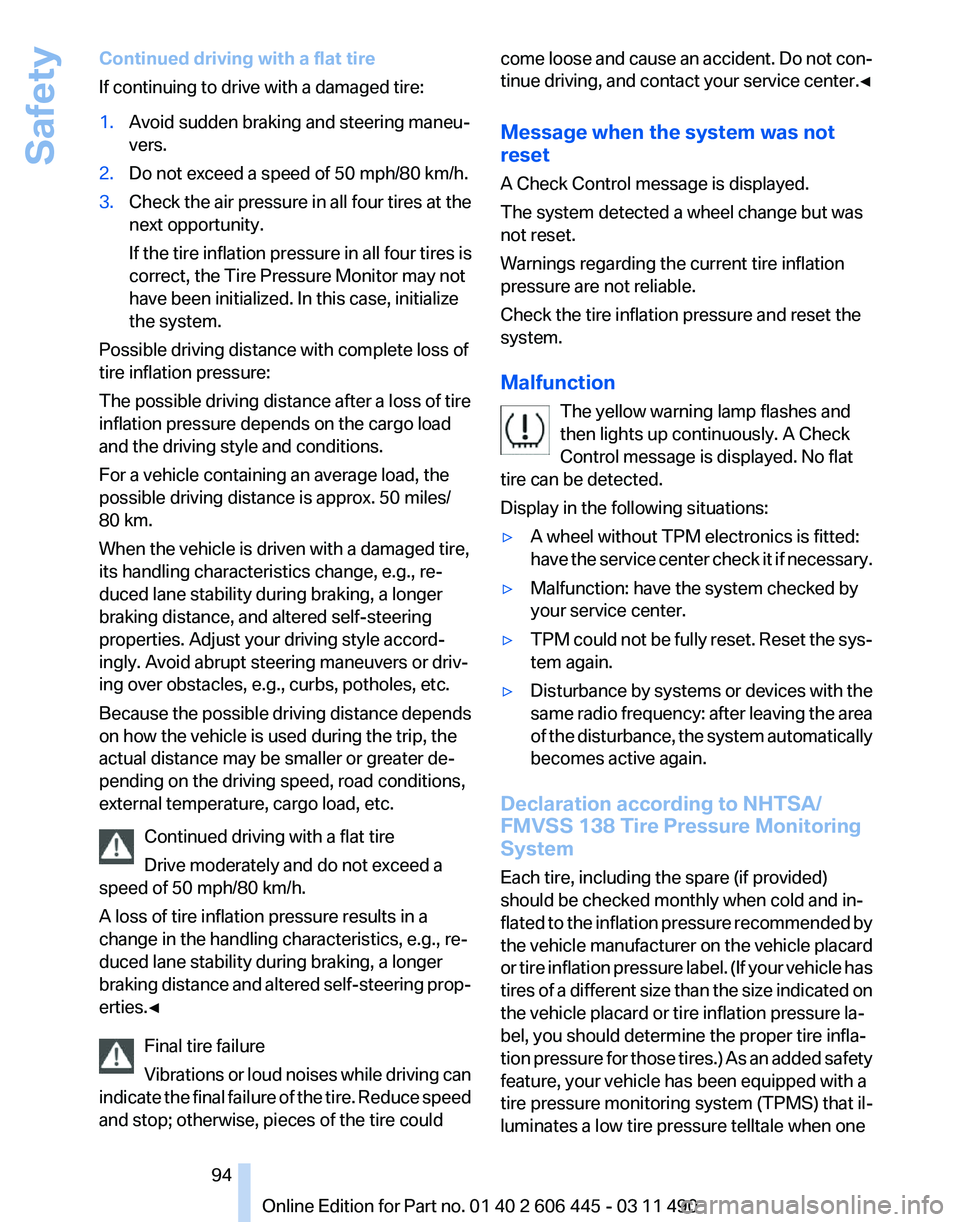
Continued driving with a flat tire
If continuing to drive with a damaged tire:
1.
Avoid sudden braking and steering maneu‐
vers.
2. Do not exceed a speed of 50 mph/80 km/h.
3. Check the air pressure in all four tires at the
next opportunity.
If the tire inflation pressure in all four tires is
correct, the Tire Pressure Monitor may not
have been initialized. In this case, initialize
the system.
Possible driving distance with complete loss of
tire inflation pressure:
The possible driving distance after a loss of tire
inflation pressure depends on the cargo load
and the driving style and conditions.
For a vehicle containing an average load, the
possible driving distance is approx. 50 miles/
80 km.
When the vehicle is driven with a damaged tire,
its handling characteristics change, e.g., re‐
duced lane stability during braking, a longer
braking distance, and altered self-steering
properties. Adjust your driving style accord‐
ingly. Avoid abrupt steering maneuvers or driv‐
ing over obstacles, e.g., curbs, potholes, etc.
Because
the possible driving distance depends
on how the vehicle is used during the trip, the
actual distance may be smaller or greater de‐
pending on the driving speed, road conditions,
external temperature, cargo load, etc.
Continued driving with a flat tire
Drive moderately and do not exceed a
speed of 50 mph/80 km/h.
A loss of tire inflation pressure results in a
change in the handling characteristics, e.g., re‐
duced lane stability during braking, a longer
braking distance and altered self-steering prop‐
erties.◀
Final tire failure
Vibrations or loud noises while driving can
indicate the final failure of the tire. Reduce speed
and stop; otherwise, pieces of the tire could come loose and cause an accident. Do not con‐
tinue
driving, and contact your service center.◀
Message when the system was not
reset
A Check Control message is displayed.
The system detected a wheel change but was
not reset.
Warnings regarding the current tire inflation
pressure are not reliable.
Check the tire inflation pressure and reset the
system.
Malfunction The yellow warning lamp flashes and
then lights up continuously. A Check
Control message is displayed. No flat
tire can be detected.
Display in the following situations:
▷ A wheel without TPM electronics is fitted:
have
the service center check it if necessary.
▷ Malfunction: have the system checked by
your service center.
▷ TPM could not be fully reset. Reset the sys‐
tem again.
▷ Disturbance by systems or devices with the
same
radio frequency: after leaving the area
of the disturbance, the system automatically
becomes active again.
Declaration according to NHTSA/
FMVSS 138 Tire Pressure Monitoring
System
Each tire, including the spare (if provided)
should be checked monthly when cold and in‐
flated
to the inflation pressure recommended by
the vehicle manufacturer on the vehicle placard
or tire inflation pressure label. (If your vehicle has
tires of a different size than the size indicated on
the vehicle placard or tire inflation pressure la‐
bel, you should determine the proper tire infla‐
tion pressure for those tires.) As an added safety
feature, your vehicle has been equipped with a
tire pressure monitoring system (TPMS) that il‐
luminates a low tire pressure telltale when one Seite 94
94 Online Edition for Part no. 01 40 2 606 445 - 03 11 490
Safety
Page 243 of 297
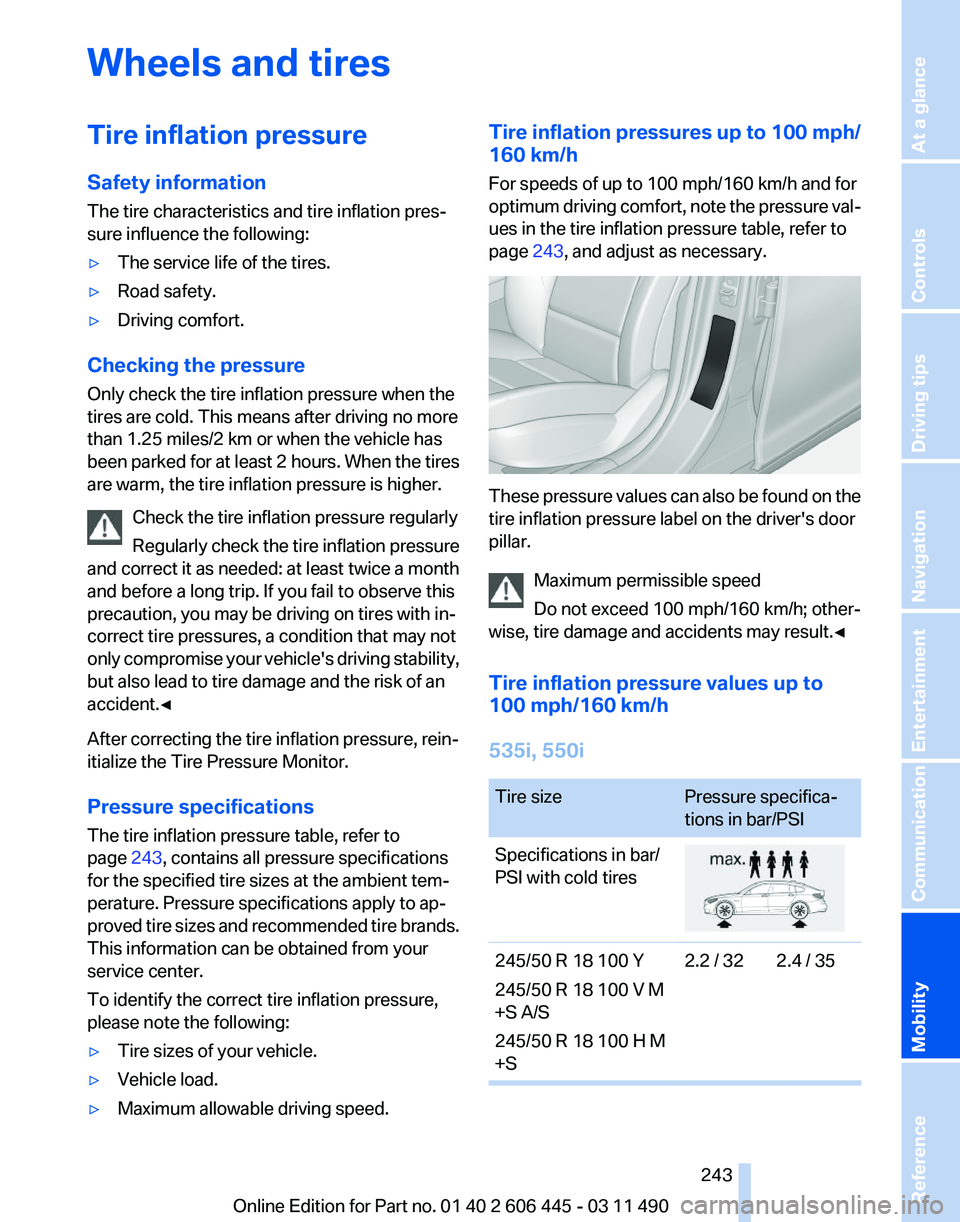
Wheels and tires
Tire inflation pressure
Safety information
The tire characteristics and tire inflation pres‐
sure influence the following:
▷
The service life of the tires.
▷ Road safety.
▷ Driving comfort.
Checking the pressure
Only check the tire inflation pressure when the
tires are cold. This means after driving no more
than 1.25 miles/2 km or when the vehicle has
been
parked for at least 2 hours. When the tires
are warm, the tire inflation pressure is higher.
Check the tire inflation pressure regularly
Regularly check the tire inflation pressure
and correct it as needed: at least twice a month
and before a long trip. If you fail to observe this
precaution, you may be driving on tires with in‐
correct tire pressures, a condition that may not
only compromise your vehicle's driving stability,
but also lead to tire damage and the risk of an
accident.◀
After correcting the tire inflation pressure, rein‐
itialize the Tire Pressure Monitor.
Pressure specifications
The tire inflation pressure table, refer to
page 243, contains all pressure specifications
for the specified tire sizes at the ambient tem‐
perature. Pressure specifications apply to ap‐
proved tire sizes and recommended tire brands.
This information can be obtained from your
service center.
To identify the correct tire inflation pressure,
please note the following:
▷ Tire sizes of your vehicle.
▷ Vehicle load.
▷ Maximum allowable driving speed. Tire inflation pressures up to 100 mph/
160 km/h
For speeds of up to 100 mph/160 km/h and for
optimum
driving comfort, note the pressure val‐
ues in the tire inflation pressure table, refer to
page 243, and adjust as necessary. These pressure values can also be found on the
tire inflation pressure label on the driver's door
pillar.
Maximum permissible speed
Do not exceed 100 mph/160 km/h; other‐
wise, tire damage and accidents may result.
◀
Tire inflation pressure values up to
100 mph/160 km/h
535i, 550i Tire size
Pressure specifica‐
tions in bar/PSI
Specifications in bar/
PSI with cold tires 245/50 R 18 100 Y
245/50 R 18 100 V M
+S A/S
245/50 R 18 100 H M
+S
2.2 / 32 2.4 / 35 Seite 243
243Online Edition for Part no. 01 40 2 606 445 - 03 11 490
Reference
Mobility Communication Entertainment Navigation Driving tips Controls At a glance
Page 244 of 297
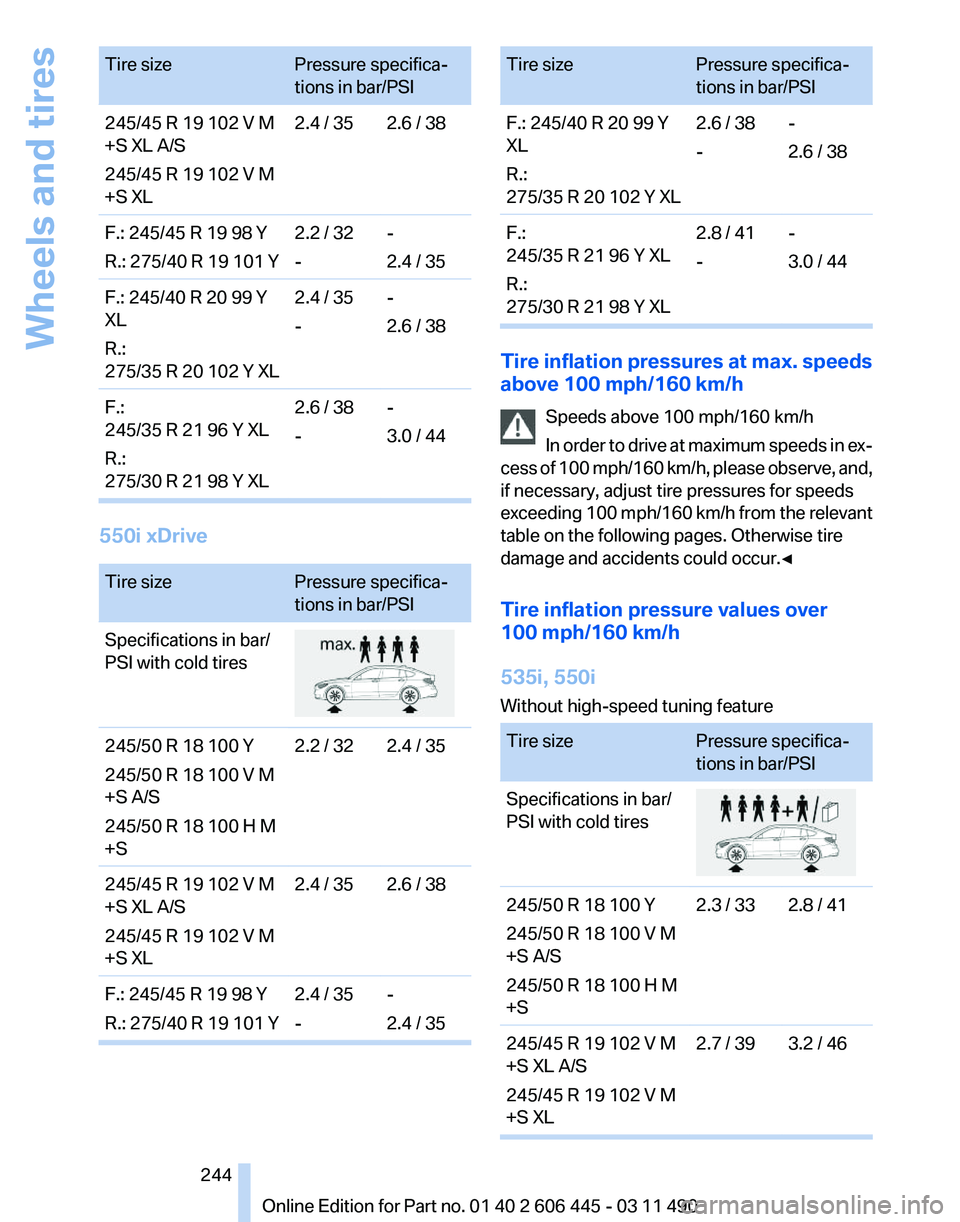
Tire size
Pressure specifica‐
tions in bar/PSI
245/45 R 19 102 V M
+S XL A/S
245/45 R 19 102 V M
+S XL 2.4 / 35 2.6 / 38
F.: 245/45 R 19 98 Y
R.: 275/40 R 19 101 Y 2.2 / 32
--
2.4 / 35
F.: 245/40 R 20 99 Y
XL
R.:
275/35 R 20 102 Y XL 2.4 / 35
-
-
2.6 / 38
F.:
245/35 R 21 96 Y XL
R.:
275/30 R 21 98 Y XL 2.6 / 38
-
-
3.0 / 44 550i xDrive
Tire size
Pressure specifica‐
tions in bar/PSI
Specifications in bar/
PSI with cold tires 245/50 R 18 100 Y
245/50 R 18 100 V M
+S A/S
245/50 R 18 100 H M
+S
2.2 / 32 2.4 / 35
245/45 R 19 102 V M
+S XL A/S
245/45 R 19 102 V M
+S XL 2.4 / 35 2.6 / 38
F.: 245/45 R 19 98 Y
R.: 275/40 R 19 101 Y 2.4 / 35
--
2.4 / 35 Tire size
Pressure specifica‐
tions in bar/PSI
F.: 245/40 R 20 99 Y
XL
R.:
275/35 R 20 102 Y XL 2.6 / 38
-
-
2.6 / 38
F.:
245/35 R 21 96 Y XL
R.:
275/30 R 21 98 Y XL 2.8 / 41
-
-
3.0 / 44 Tire inflation pressures at max. speeds
above 100 mph/160 km/h
Speeds above 100 mph/160 km/h
In
order to drive at maximum speeds in ex‐
cess of 100 mph/160 km/h, please observe, and,
if necessary, adjust tire pressures for speeds
exceeding 100 mph/160 km/h from the relevant
table on the following pages. Otherwise tire
damage and accidents could occur.◀
Tire inflation pressure values over
100 mph/160 km/h
535i, 550i
Without high-speed tuning feature Tire size
Pressure specifica‐
tions in bar/PSI
Specifications in bar/
PSI with cold tires 245/50 R 18 100 Y
245/50 R 18 100 V M
+S A/S
245/50 R 18 100 H M
+S
2.3 / 33 2.8 / 41
245/45 R 19 102 V M
+S XL A/S
245/45 R 19 102 V M
+S XL 2.7 / 39 3.2 / 46 Seite 244
244 Online Edition for Part no. 01 40 2 606 445 - 03 11 490Wheels and tires
Page 246 of 297
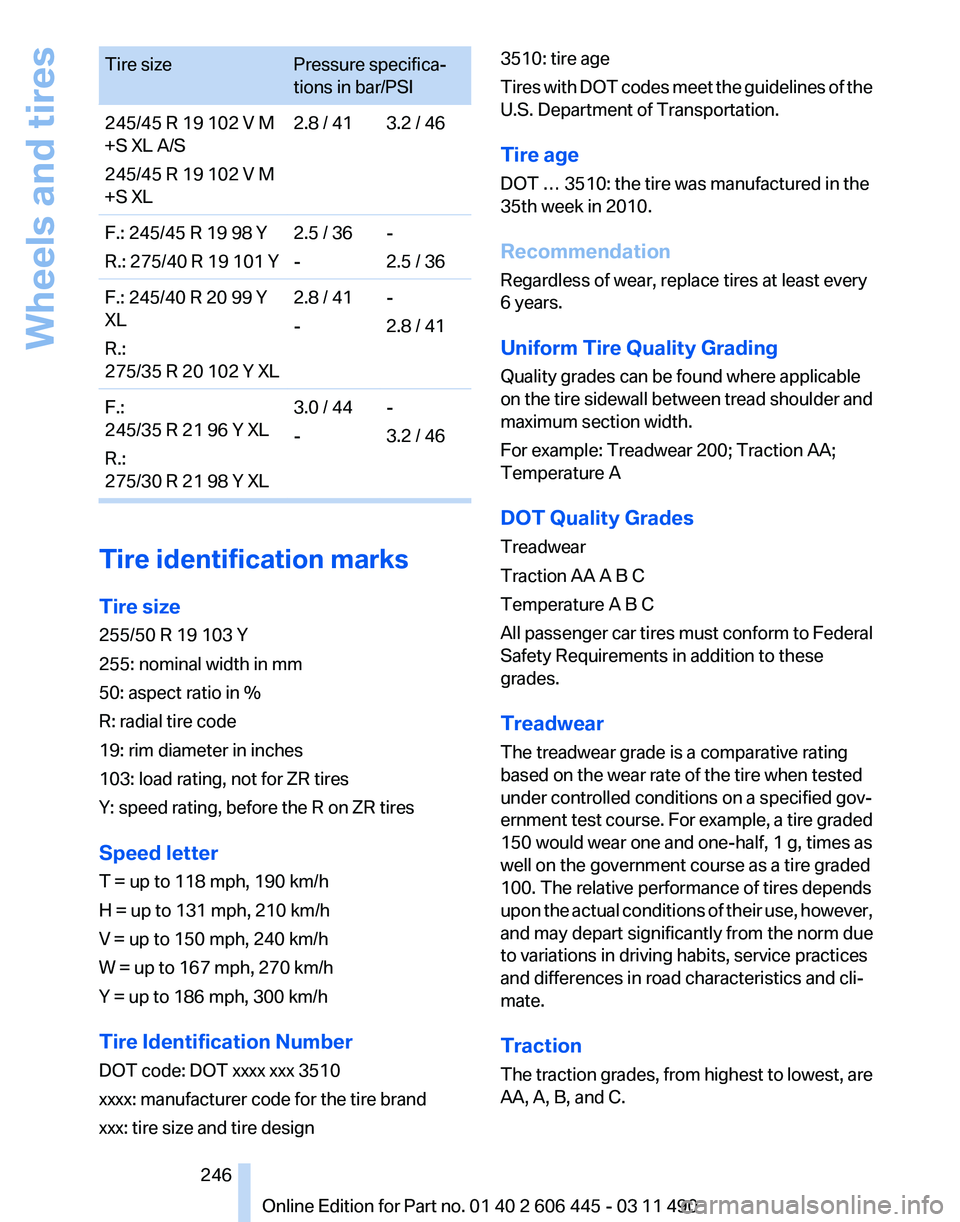
Tire size
Pressure specifica‐
tions in bar/PSI
245/45 R 19 102 V M
+S XL A/S
245/45 R 19 102 V M
+S XL 2.8 / 41 3.2 / 46
F.: 245/45 R 19 98 Y
R.: 275/40 R 19 101 Y 2.5 / 36
--
2.5 / 36
F.: 245/40 R 20 99 Y
XL
R.:
275/35 R 20 102 Y XL 2.8 / 41
-
-
2.8 / 41
F.:
245/35 R 21 96 Y XL
R.:
275/30 R 21 98 Y XL 3.0 / 44
-
-
3.2 / 46 Tire identification marks
Tire size
255/50 R 19 103 Y
255: nominal width in mm
50: aspect ratio in %
R: radial tire code
19: rim diameter in inches
103: load rating, not for ZR tires
Y: speed rating, before the R on ZR tires
Speed letter
T = up to 118 mph, 190 km/h
H = up to 131 mph, 210 km/h
V = up to 150 mph, 240 km/h
W = up to 167 mph, 270 km/h
Y = up to 186 mph, 300 km/h
Tire Identification Number
DOT code: DOT xxxx xxx 3510
xxxx: manufacturer code for the tire brand
xxx: tire size and tire design 3510: tire age
Tires
with DOT codes meet the guidelines of the
U.S. Department of Transportation.
Tire age
DOT … 3510: the tire was manufactured in the
35th week in 2010.
Recommendation
Regardless of wear, replace tires at least every
6 years.
Uniform Tire Quality Grading
Quality grades can be found where applicable
on the tire sidewall between tread shoulder and
maximum section width.
For example: Treadwear 200; Traction AA;
Temperature A
DOT Quality Grades
Treadwear
Traction AA A B C
Temperature A B C
All passenger car tires must conform to Federal
Safety Requirements in addition to these
grades.
Treadwear
The treadwear grade is a comparative rating
based on the wear rate of the tire when tested
under controlled conditions on a specified gov‐
ernment test course. For example, a tire graded
150 would wear one and one-half, 1 g, times as
well on the government course as a tire graded
100. The relative performance of tires depends
upon the actual conditions of their use, however,
and may depart significantly from the norm due
to variations in driving habits, service practices
and differences in road characteristics and cli‐
mate.
Traction
The traction grades, from highest to lowest, are
AA, A, B, and C.
Seite 246
246 Online Edition for Part no. 01 40 2 606 445 - 03 11 490
Wheels and tires
Page 248 of 297
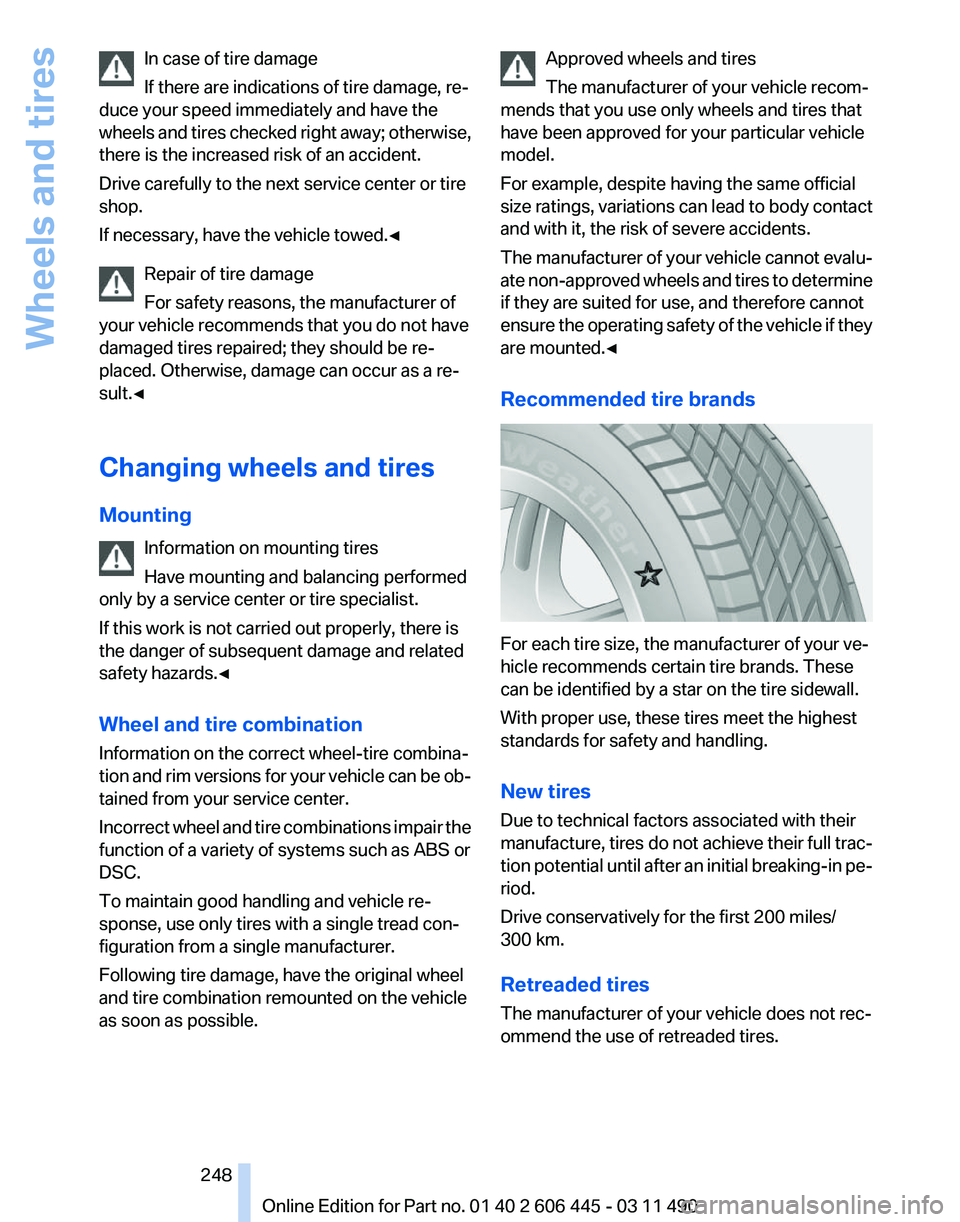
In case of tire damage
If there are indications of tire damage, re‐
duce your speed immediately and have the
wheels
and tires checked right away; otherwise,
there is the increased risk of an accident.
Drive carefully to the next service center or tire
shop.
If necessary, have the vehicle towed.◀
Repair of tire damage
For safety reasons, the manufacturer of
your vehicle recommends that you do not have
damaged tires repaired; they should be re‐
placed. Otherwise, damage can occur as a re‐
sult.◀
Changing wheels and tires
Mounting
Information on mounting tires
Have mounting and balancing performed
only by a service center or tire specialist.
If this work is not carried out properly, there is
the danger of subsequent damage and related
safety hazards.◀
Wheel and tire combination
Information on the correct wheel-tire combina‐
tion and rim versions for your vehicle can be ob‐
tained from your service center.
Incorrect wheel and tire combinations impair the
function of a variety of systems such as ABS or
DSC.
To maintain good handling and vehicle re‐
sponse, use only tires with a single tread con‐
figuration from a single manufacturer.
Following tire damage, have the original wheel
and tire combination remounted on the vehicle
as soon as possible. Approved wheels and tires
The manufacturer of your vehicle recom‐
mends that you use only wheels and tires that
have been approved for your particular vehicle
model.
For example, despite having the same official
size
ratings, variations can lead to body contact
and with it, the risk of severe accidents.
The manufacturer of your vehicle cannot evalu‐
ate non-approved wheels and tires to determine
if they are suited for use, and therefore cannot
ensure the operating safety of the vehicle if they
are mounted.◀
Recommended tire brands For each tire size, the manufacturer of your ve‐
hicle recommends certain tire brands. These
can be identified by a star on the tire sidewall.
With proper use, these tires meet the highest
standards for safety and handling.
New tires
Due to technical factors associated with their
manufacture,
tires do not achieve their full trac‐
tion potential until after an initial breaking-in pe‐
riod.
Drive conservatively for the first 200 miles/
300 km.
Retreaded tires
The manufacturer of your vehicle does not rec‐
ommend the use of retreaded tires. Seite 248
248 Online Edition for Part no. 01 40 2 606 445 - 03 11 490
Wheels and tires
Page 249 of 297
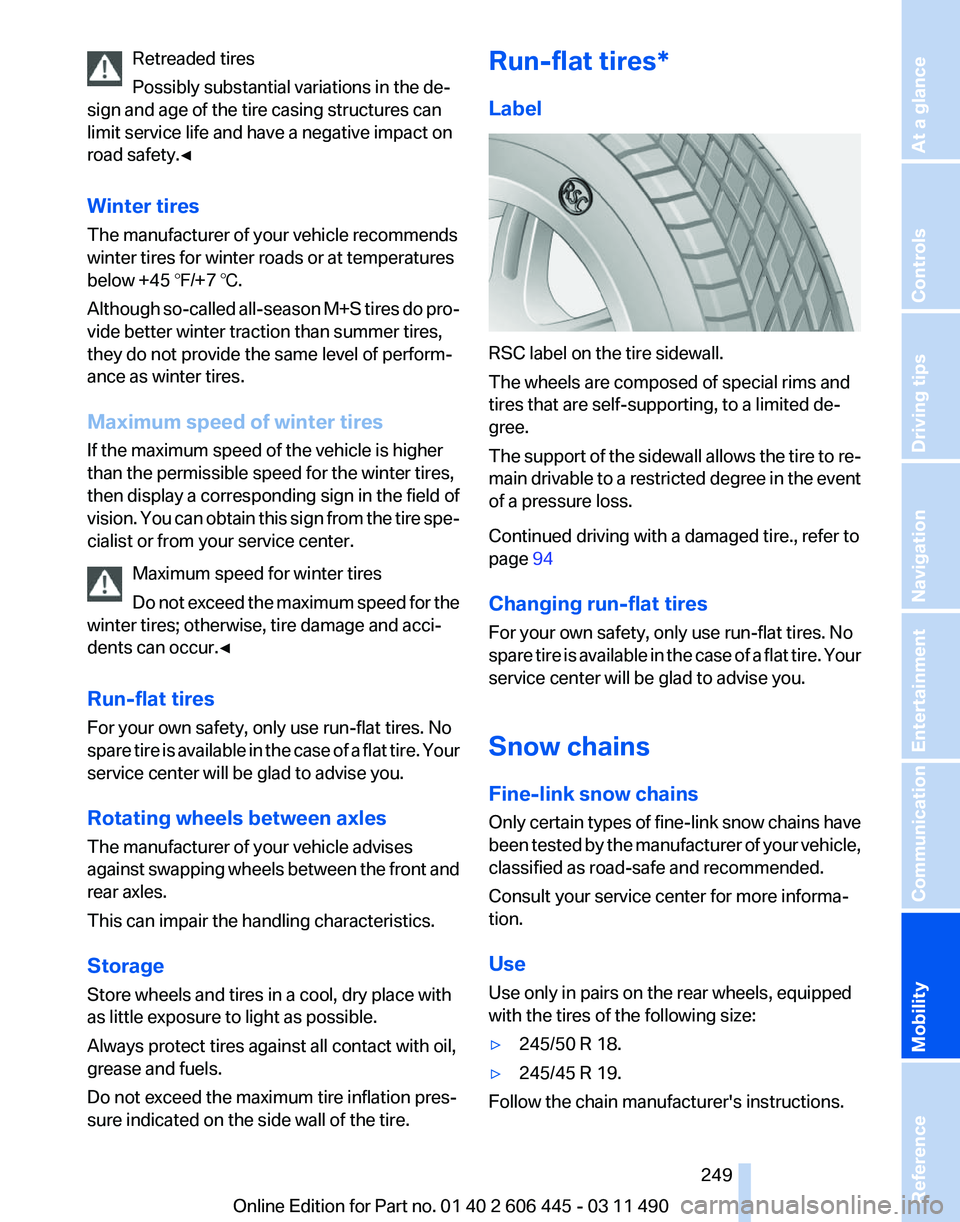
Retreaded tires
Possibly substantial variations in the de‐
sign and age of the tire casing structures can
limit service life and have a negative impact on
road safety.◀
Winter tires
The manufacturer of your vehicle recommends
winter tires for winter roads or at temperatures
below +45 ℉/+7 ℃.
Although
so-called all-season M+S tires do pro‐
vide better winter traction than summer tires,
they do not provide the same level of perform‐
ance as winter tires.
Maximum speed of winter tires
If the maximum speed of the vehicle is higher
than the permissible speed for the winter tires,
then display a corresponding sign in the field of
vision. You can obtain this sign from the tire spe‐
cialist or from your service center.
Maximum speed for winter tires
Do not exceed the maximum speed for the
winter tires; otherwise, tire damage and acci‐
dents can occur.◀
Run-flat tires
For your own safety, only use run-flat tires. No
spare tire is available in the case of a flat tire. Your
service center will be glad to advise you.
Rotating wheels between axles
The manufacturer of your vehicle advises
against swapping wheels between the front and
rear axles.
This can impair the handling characteristics.
Storage
Store wheels and tires in a cool, dry place with
as little exposure to light as possible.
Always protect tires against all contact with oil,
grease and fuels.
Do not exceed the maximum tire inflation pres‐
sure indicated on the side wall of the tire. Run-flat tires*
Label
RSC label on the tire sidewall.
The wheels are composed of special rims and
tires that are self-supporting, to a limited de‐
gree.
The
support of the sidewall allows the tire to re‐
main drivable to a restricted degree in the event
of a pressure loss.
Continued driving with a damaged tire., refer to
page 94
Changing run-flat tires
For your own safety, only use run-flat tires. No
spare tire is available in the case of a flat tire. Your
service center will be glad to advise you.
Snow chains
Fine-link snow chains
Only certain types of fine-link snow chains have
been tested by the manufacturer of your vehicle,
classified as road-safe and recommended.
Consult your service center for more informa‐
tion.
Use
Use only in pairs on the rear wheels, equipped
with the tires of the following size:
▷ 245/50 R 18.
▷ 245/45 R 19.
Follow the chain manufacturer's instructions.
Seite 249
249Online Edition for Part no. 01 40 2 606 445 - 03 11 490
Reference
Mobility Communication Entertainment Navigation Driving tips Controls At a glance
Page 293 of 297
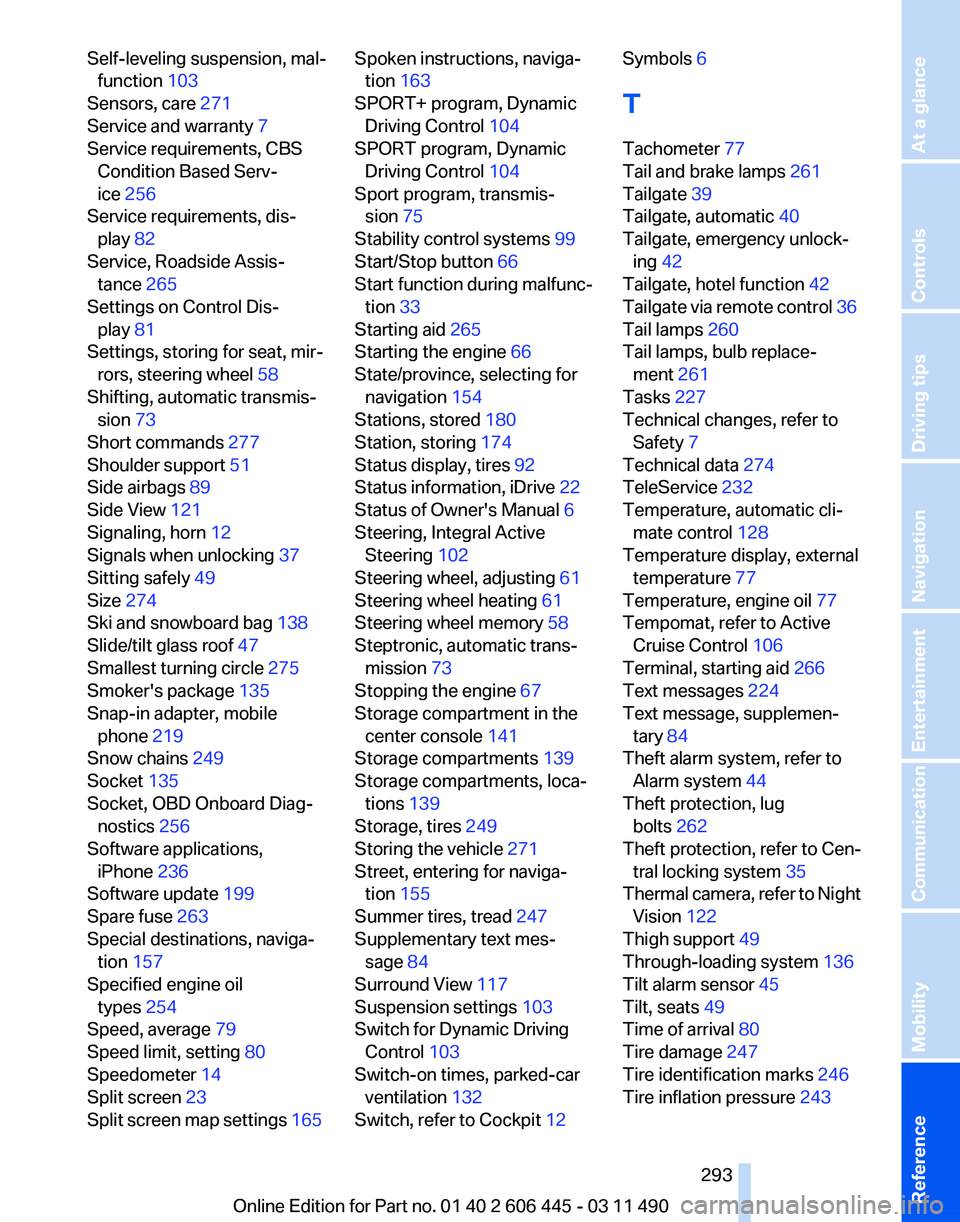
Self-leveling suspension, mal‐
function 103
Sensors, care 271
Service and warranty 7
Service requirements, CBS Condition Based Serv‐
ice 256
Service requirements, dis‐ play 82
Service, Roadside Assis‐ tance 265
Settings on Control Dis‐ play 81
Settings, storing for seat, mir‐ rors, steering wheel 58
Shifting, automatic transmis‐ sion 73
Short commands 277
Shoulder support 51
Side airbags 89
Side View 121
Signaling, horn 12
Signals when unlocking 37
Sitting safely 49
Size 274
Ski and snowboard bag 138
Slide/tilt glass roof 47
Smallest turning circle 275
Smoker's package 135
Snap-in adapter, mobile phone 219
Snow chains 249
Socket 135
Socket, OBD Onboard Diag‐ nostics 256
Software applications, iPhone 236
Software update 199
Spare fuse 263
Special destinations, naviga‐ tion 157
Specified engine oil types 254
Speed, average 79
Speed limit, setting 80
Speedometer 14
Split screen 23
Split
screen map settings 165 Spoken instructions, naviga‐
tion 163
SPORT+ program, Dynamic Driving Control 104
SPORT program, Dynamic Driving Control 104
Sport program, transmis‐ sion 75
Stability control systems 99
Start/Stop button 66
Start function during malfunc‐ tion 33
Starting aid 265
Starting the engine 66
State/province, selecting for navigation 154
Stations, stored 180
Station, storing 174
Status display, tires 92
Status information, iDrive 22
Status of Owner's Manual 6
Steering, Integral Active Steering 102
Steering wheel, adjusting 61
Steering wheel heating 61
Steering wheel memory 58
Steptronic, automatic trans‐ mission 73
Stopping the engine 67
Storage compartment in the center console 141
Storage compartments 139
Storage compartments, loca‐ tions 139
Storage, tires 249
Storing the vehicle 271
Street, entering for naviga‐ tion 155
Summer tires, tread 247
Supplementary text mes‐ sage 84
Surround View 117
Suspension settings 103
Switch for Dynamic Driving Control 103
Switch-on times, parked-car ventilation 132
Switch, refer to Cockpit 12 Symbols 6
T
Tachometer 77
Tail and brake lamps
261
Tailgate 39
Tailgate, automatic 40
Tailgate, emergency unlock‐ ing 42
Tailgate, hotel function 42
Tailgate
via remote control 36
Tail lamps 260
Tail lamps, bulb replace‐ ment 261
Tasks 227
Technical changes, refer to Safety 7
Technical data 274
TeleService 232
Temperature, automatic cli‐ mate control 128
Temperature display, external temperature 77
Temperature, engine oil 77
Tempomat, refer to Active Cruise Control 106
Terminal, starting aid 266
Text messages 224
Text message, supplemen‐ tary 84
Theft alarm system, refer to Alarm system 44
Theft protection, lug bolts 262
Theft protection, refer to Cen‐ tral locking system 35
Thermal camera, refer to Night Vision 122
Thigh support 49
Through-loading system 136
Tilt alarm sensor 45
Tilt, seats 49
Time of arrival 80
Tire damage 247
Tire identification marks 246
Tire inflation pressure 243
Seite 293
293Online Edition for Part no. 01 40 2 606 445 - 03 11 490
Reference Mobility Communication Entertainment Navigation Driving tips Controls At a glance